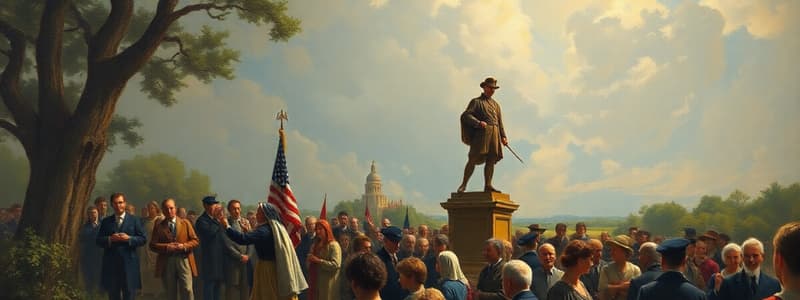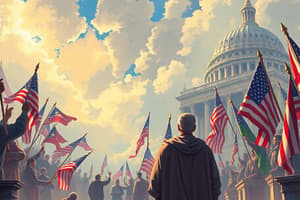Podcast
Questions and Answers
What was a key characteristic of the government established by the Articles of Confederation?
What was a key characteristic of the government established by the Articles of Confederation?
- It could independently levy taxes.
- It provided equal representation with one vote per state in Congress. (correct)
- It had a bicameral legislature.
- It had a strong executive branch with significant powers.
Which event illustrated the weaknesses of the Articles of Confederation and prompted calls for change?
Which event illustrated the weaknesses of the Articles of Confederation and prompted calls for change?
- The Annapolis Convention of 1786
- The Constitutional Convention of 1787
- Shay’s Rebellion in Massachusetts (correct)
- The adoption of the Bill of Rights
What was one of James Madison's goals for creating the Constitution?
What was one of James Madison's goals for creating the Constitution?
- To ensure that all representation was equal, regardless of population.
- To create a republic that lasts. (correct)
- To create a government with no checks and balances.
- To establish a system where the national government is supreme over states.
Which fundamental principle is NOT found in the Constitution?
Which fundamental principle is NOT found in the Constitution?
What was a significant outcome of the Annapolis Convention in 1786?
What was a significant outcome of the Annapolis Convention in 1786?
Which of the following statements about individual rights is FALSE?
Which of the following statements about individual rights is FALSE?
Which founding figure is known as the 'Father of the Constitution'?
Which founding figure is known as the 'Father of the Constitution'?
What was one of the weaknesses of the Articles of Confederation in terms of financial power?
What was one of the weaknesses of the Articles of Confederation in terms of financial power?
Which concept was primarily aimed at avoiding tyranny in the government structure created during the Articles of Confederation?
Which concept was primarily aimed at avoiding tyranny in the government structure created during the Articles of Confederation?
What principle states that government derives its authority from the people?
What principle states that government derives its authority from the people?
Which of the following is NOT one of the inalienable rights mentioned in the Declaration of Independence?
Which of the following is NOT one of the inalienable rights mentioned in the Declaration of Independence?
In the context of competing theories of democracy, which theory suggests that no single group can dominate the policymaking process?
In the context of competing theories of democracy, which theory suggests that no single group can dominate the policymaking process?
Which idea argues that citizens must participate in political processes to ensure a functioning democracy?
Which idea argues that citizens must participate in political processes to ensure a functioning democracy?
According to elitist theory, what is a characteristic of the elites in relation to politics?
According to elitist theory, what is a characteristic of the elites in relation to politics?
Which of the following terms best describes a democratic system where the populace elects representatives to make decisions on their behalf?
Which of the following terms best describes a democratic system where the populace elects representatives to make decisions on their behalf?
What might be considered a conflict inherent in the concept of liberty within American political culture?
What might be considered a conflict inherent in the concept of liberty within American political culture?
What does the term 'national of joiners' imply about American political culture?
What does the term 'national of joiners' imply about American political culture?
In the Declaration of Independence, which of the following issues was NOT listed in Jefferson's grievances against the British government?
In the Declaration of Independence, which of the following issues was NOT listed in Jefferson's grievances against the British government?
Which of the following is NOT typically a feature of a pluralistic society according to Pluralist Theory?
Which of the following is NOT typically a feature of a pluralistic society according to Pluralist Theory?
Which plan proposed a bicameral legislature where larger states had more representation?
Which plan proposed a bicameral legislature where larger states had more representation?
What was the purpose of the Three-Fifths Compromise?
What was the purpose of the Three-Fifths Compromise?
The Great Compromise established which of the following structures?
The Great Compromise established which of the following structures?
What principle prevents any branch of government from becoming too powerful?
What principle prevents any branch of government from becoming too powerful?
Which of the following best describes the Necessary and Proper Clause?
Which of the following best describes the Necessary and Proper Clause?
Which compromise determined the timeline for the restriction of the slave trade?
Which compromise determined the timeline for the restriction of the slave trade?
Which characteristic of the Constitution allows for its amendment?
Which characteristic of the Constitution allows for its amendment?
What role does the Electoral College play in the selection of the President?
What role does the Electoral College play in the selection of the President?
Which branch of government holds the authority for judicial review?
Which branch of government holds the authority for judicial review?
What was a significant concern during the ratification debates?
What was a significant concern during the ratification debates?
Flashcards
Popular Sovereignty
Popular Sovereignty
The belief that the power of the government comes directly from the people.
Republicanism
Republicanism
A system of government where elected representatives make decisions on behalf of the people.
Natural Rights
Natural Rights
The idea that people have fundamental rights that cannot be taken away by the government.
Social Contract
Social Contract
Signup and view all the flashcards
Freedom From
Freedom From
Signup and view all the flashcards
Freedom To
Freedom To
Signup and view all the flashcards
Participation Democratic Theory
Participation Democratic Theory
Signup and view all the flashcards
Pluralist Theory
Pluralist Theory
Signup and view all the flashcards
Elitist Theory
Elitist Theory
Signup and view all the flashcards
Institutions, Systems, and Power
Institutions, Systems, and Power
Signup and view all the flashcards
Constitution
Constitution
Signup and view all the flashcards
Republic
Republic
Signup and view all the flashcards
Constitutional Republic
Constitutional Republic
Signup and view all the flashcards
Articles of Confederation
Articles of Confederation
Signup and view all the flashcards
Federalism
Federalism
Signup and view all the flashcards
Confederal System
Confederal System
Signup and view all the flashcards
Shay's Rebellion
Shay's Rebellion
Signup and view all the flashcards
Constitutional Convention
Constitutional Convention
Signup and view all the flashcards
Writ of Habeas Corpus
Writ of Habeas Corpus
Signup and view all the flashcards
Ex Post Facto Law
Ex Post Facto Law
Signup and view all the flashcards
Virginia Plan
Virginia Plan
Signup and view all the flashcards
New Jersey Plan
New Jersey Plan
Signup and view all the flashcards
Great Compromise (Connecticut Compromise)
Great Compromise (Connecticut Compromise)
Signup and view all the flashcards
Three-Fifths Compromise
Three-Fifths Compromise
Signup and view all the flashcards
Compromise on Importation
Compromise on Importation
Signup and view all the flashcards
Separation of Powers
Separation of Powers
Signup and view all the flashcards
Checks and Balances
Checks and Balances
Signup and view all the flashcards
Legislative Branch
Legislative Branch
Signup and view all the flashcards
Executive Branch
Executive Branch
Signup and view all the flashcards
Study Notes
American Political Culture
- Americans base their rights on revolutionary ideas, including democracy, natural rights, popular sovereignty, republicanism, liberty, and the pursuit of happiness.
- Enlightenment principles, such as democracy, natural rights (life, liberty, and property), and a social contract, shaped American ideals.
- The Declaration of Independence argued that British rule was illegitimate and denied natural rights; it listed grievances against the King.
Government by the People
- Popular sovereignty is the idea that government authority stems from the people.
- Republicanism emphasizes representative government, where free, fair, and frequent elections hold officials accountable.
- This contrasts with direct democracy.
Two Visions of Liberty
- Liberty encompasses social, political, and economic freedoms, and freedom from government interference.
- Conflicts may arise between individual liberty and societal order.
Competing Theories of Democracy
- Political scientists debate how power is distributed.
- Pluralist theory emphasizes the role of groups in policymaking, with no single group dominating.
- Elitist theory suggests that elites disproportionately influence policymaking.
Participation in a Democratic Society
- Widespread political participation is vital for democratic governance.
- Civil society, represented by voluntary associations, prepares citizens for democratic processes.
Pluralist Theory
- Americans unite for a shared purpose through like-minded groups.
- Groups compete to influence policy.
- This leads to compromise and bargaining.
Elitist Theory
- A minority holds considerable influence in politics.
- Wealthy groups and donors significantly impact policy decisions.
Institutions, Systems, and Power
- Governments need to decide how much power they will have, and how power will be distributed.
- Constitutional Republic: A system with elected representatives and a supreme law (the Constitution).
The Constitution
- Adopted by the Second Continental Congress, it aimed to form a "league of friendship" among states.
- Issues included a lack of "hard money," debt, inability to regulate commerce between states, and the inability to raise an army to deal with rebellion.
- Shay's Rebellion highlighted the Articles of Confederation's weakness.
- Key goals included protecting individual liberties, creating a strong national government, and ensuring a balance of power.
Protecting Freedoms
- Key protections include writ of habeas corpus, prohibiting bills of attainder, and preventing ex post facto laws.
Representation in Congress
- Debates over representation in Congress led to the Great Compromise, creating a bicameral legislature.
- The Virginia Plan favored larger states, while the New Jersey Plan favored smaller states.
The End of the Articles
- The Annapolis Convention addressed trade disputes, though participation was low.
- Shay's Rebellion demonstrated the Articles of Confederation's weakness, leading to a call for a stronger national government.
- Problems included a shortage of hard money, trade issues, and difficulty regulating commerce and taxation.
Ratification Debates
- Supporters (Federalists) favored a strong national government.
- Opponents (Antifederalists) worried about the concentration of power.
- The debate centered around the feasibility of republican government, the balance of power between states and the federal government, and the need for a bill of rights.
The Constitution
- The Constitution establishes the foundations of American governance, defining the powers.
Checks and Balances
- Separation of powers: power is distributed among three branches (legislative, executive, judicial).
- Checks and balances prevent any single branch from becoming too powerful.
Federalism
- Federalism: sharing of power between state and national governments.
- Enumerated powers are specifically listed in the Constitution.
- Necessary and Proper Clause grants Congress flexibility in carrying out enumerated powers.
Studying That Suits You
Use AI to generate personalized quizzes and flashcards to suit your learning preferences.




